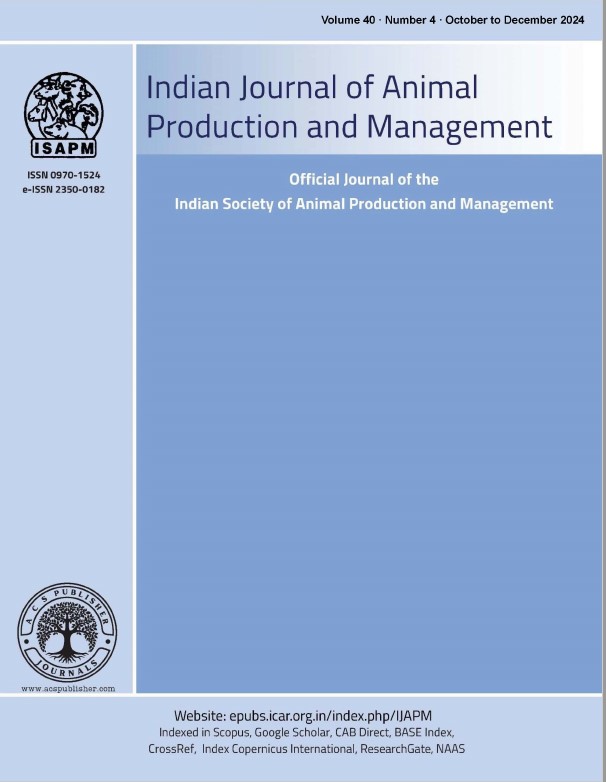Prevalence of mastitis and their relations with risk factors in extensively managed sheep flocks
DOI:
https://doi.org/10.48165/ijapm.2025.41.1.7Keywords:
Clinical Mastitis, Floor hygiene, Parity, Prevalence, Risk factors, Sheep flocksAbstract
Mastitis presents a significant challenge in sheep flocks, akin to its impact on high producing dairy cows. This condition not only reduces milk yield but also negatively affects pre-weaning lamb growth, potentially increasing lamb mortality due to starvation in meat-producing flocks. In India, particularly in Sabarkantha district, data on the prevalence of clinical mastitis in extensively managed sheep flocks are limited, partly due to the practice of not milking ewes, which leads to undetected cases. This study aimed to assess the prevalence of clinical mastitis and its association with various risk factors in Sabarkantha district of Gujarat, where sheep are traditionally managed by the Bharvad community through grazing in both hilly and plain areas. A total of 21 flocks from 12 villages were randomly selected, with 6 villages each from plain and hilly regions involving 617 lactating ewes. Clinical mastitis was diagnosed based on symptoms such as udder swelling and abnormal milk. Data on risk factors including parity number, floor hygiene, treatment practices, and flock size were also collected. Composite milk samples from affected ewes were analyzed for bacterial culture and identification. The results showed that the overall prevalence of clinical mastitis in ewes was 10.19±0.64%. Flocks size was found to be associated with mastitis prevalence %, as it was higher i.e. 13.71% in larger flocks compare to small or medium sized flocks may be attributed to poorer hygiene conditions particularly in large flocks. Parity number and regional differences significantly impacted mastitis prevalence, with higher prevalence in sheep with more parities and in plain regions compared to hilly areas. Treatment practices were found to significantly affect mastitis frequency, with a notable decrease in prevalence when treatment was administered. Bacteriological analysis of 47 positive mastitis cases revealed Staphylococcus spp. as the most common pathogen, followed by Streptococcus spp., E. coli, Pseudomonas spp., and other Gram-negative bacteria. The study highlights the need for targeted mastitis control strategies, considering factors such as parity number, regional differences, and treatment practices, to effectively manage mastitis in grazing sheep systems.
References
Arsenault, J., Dubreuil, P., Higgins, R., & Bélanger, D. (2008). Risk factors and impacts of clinical and subclinical mastitis in commercial meat-producing sheep flocks in Quebec, Canada. Preventive Veterinary Medicine, 87(3–4), 373–393.
Barrow, G. I., & Feltham, R. K. A. (1993). Cowan and Steel’s manual for the identification of medical bacteria (3rd ed., pp. 140–143). Cambridge University Press.
Beheshti, R., Shaieghi, J., Eshratkhah, B., Ghalehkandi, J. G., & Maheri-Sis, N. (2010). Prevalence and etiology of subclinical mastitis in ewes of the Tabriz region, Iran. Global Veterinaria, 4(3), 299–302.
Chambers, G., Laven, R., Grinberg, A., Ridler, A., & Velathanthiri, N. (2024). An observational study of farmer-reported clinical mastitis in New Zealand dairy ewes. New Zealand Veterinary Journal, 72(4), 212–224. https://doi.org/10.1080/00480169.2024.2344566
Cowan, S. T., & Steel, K. J. (1974). Manual for the identification of medical bacteria (3rd ed., pp. 140–143). Cambridge University Press.
Gougoulis, D., Athanasiou, L. V., Vasileiou, N. G., Voulgarakis, N., Dimoveli, K., & Mavrogianni, V. (2023). Outbreak of acute clinical mastitis in primigravidae ewes in the immediately pre-partum period. Ruminants, 3(2), 133–139.
Knuth, R. M., Woodruff, K. L., Hummel, G. L., Williams, J. D., Austin, K. J., Stewart, W. C., Cunningham-Hollinger, H. C., & Bisha, B. (2022). Effects of management strategies during early lactation and weaning on etiological agents of ovine subclinical mastitis and antimicrobial susceptibility of milk-derived bacterial isolates. Journal of Animal Science, 100(6), skac171. https://doi.org/10.1093/jas/skac171
Mahlangu, P., Maina, N., & Kagira, J. (2018). Prevalence, risk factors, and antibiogram of bacteria isolated from milk of goats with subclinical mastitis in Thika East Subcounty, Kenya. Journal of Veterinary Medicine, 2018, 3801479. https://doi.org/10.1155/2018/3801479
Megersa, B., Tadesse, C., Abunna, F., Regassa, A., Mekibib, B., & Debela, E. (2010). Occurrence of mastitis and associated risk factors in lactating goats under pastoral management in Borana, Southern Ethiopia. Tropical Animal Health and Production, 42(6), 1249–1255.
Michael, C. K., Lianou, D. T., Tsilipounidaki, K., Florou, Z., Vasileiou, N. G. C., Mavrogianni, V. S., Petinaki, E., & Fthenakis, G. C. (2023). Longitudinal study of antibiotic resistance of staphylococci from cases of subclinical mastitis in sheep in Greece: Incidence and risk factors. Antibiotics, 12(12), 1703. https://doi.org/10.3390/antibiotics12121703
Mørk, T., Waage, S., Tollersrud, T., Kvitle, B., & Sviland, S. (2007). Clinical mastitis in ewes: Bacteriology, epidemiology and clinical features. Acta Veterinaria Scandinavica, 49, 23. https://doi.org/10.1186/1751-0147-49-23
Smith, E. M., Willis, Z. N., Blakeley, M., Lovatt, F., Purdy, K. J., & Green, L. E. (2015). Bacterial species and their associations with acute and chronic mastitis in suckler ewes. Journal of Dairy Science, 98(10), 7025–7033. https://doi.org/10.3168/jds.2015-9702
Sorathiya, L. M., Fulsoundar, A. B., Tyagi, K. K., & Patel, M. D. (2016). Seasonality in feed availability and nutritional status in goats of south Gujarat heavy rainfall region. Indian Journal of Animal Sciences, 86(4), 105–108.
Waage, S., & Vatn, S. (2008). Individual animal risk factors for clinical mastitis in meat sheep in Norway. Preventive Veterinary Medicine, 87(3–4), 229–243.
Watson, D. J., & Buswell, J. F. (1984). Modern aspects of sheep mastitis. British Veterinary Journal, 140(6), 529–534.

